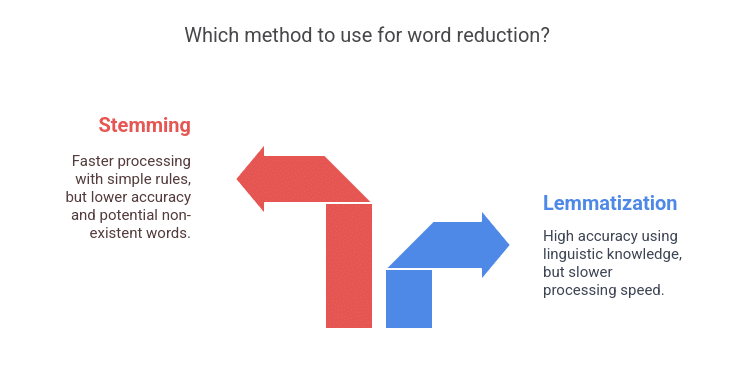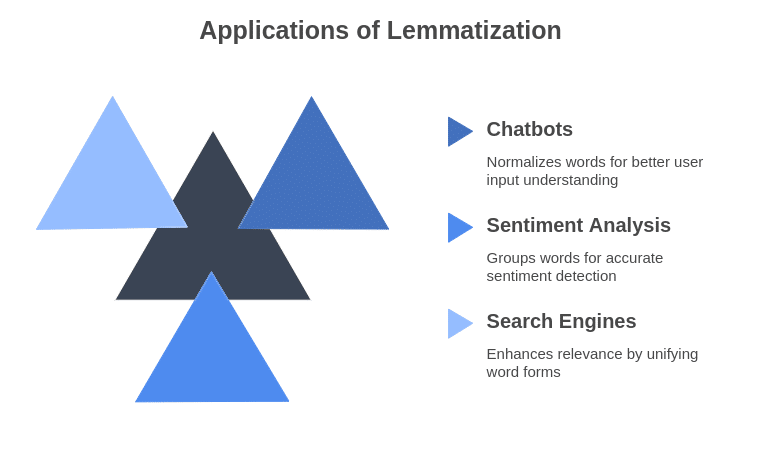Have you ever been curious about how search engines can comprehend your queries, even with different word forms? Or how chatbots can accurately understand and respond to variations in language?
The answer lies in Natural Language Processing (NLP), a captivating field of artificial intelligence that empowers machines to understand and process human language.
One of the fundamental techniques in NLP is lemmatization, which enhances text processing by reducing words to their base or dictionary form. Unlike simple word truncation, lemmatization considers context and meaning, ensuring more precise language interpretation.
Whether it’s refining search results, enhancing chatbot interactions, or aiding text analysis, lemmatization plays a vital role in various applications.
In this post, we’ll delve into what lemmatization entails, how it differs from stemming, its significance in NLP, and how you can implement it using Python. Let’s get started!
Understanding Lemmatization
Lemmatization involves converting a word to its base form (lemma) while taking into account its context and meaning. Unlike stemming, which simply removes suffixes to produce root words, lemmatization guarantees that the transformed word is a valid entry in the dictionary. This makes lemmatization more reliable for text processing.
For example:
- Running → Run
- Studies → Study
- Better → Good (Lemmatization considers meaning, unlike stemming)
Further Reading: What is Stemming in NLP?
Functioning of Lemmatization
Lemmatization typically includes:
- Tokenization: Breaking text into words.
- Example: Sentence: “The cats are playing in the garden.”
- After tokenization: [‘The’, ‘cats’, ‘are’, ‘playing’, ‘in’, ‘the’, ‘garden’]
- Part-of-Speech (POS) Tagging: Identifying a word’s role (noun, verb, adjective, etc.).
- Example: cats (noun), are (verb), playing (verb), garden (noun)
- POS tagging assists in distinguishing between words with multiple forms, such as “running” (verb) vs. “running” (adjective, as in “running water”).
- Applying Lemmatization Rules: Transforming words into their base form using a lexical database.
- Example:
- playing → play
- cats → cat
- better → good
- Without POS tagging, “playing” might not be lemmatized accurately. POS tagging ensures that “playing” is correctly converted into “play” as a verb.
- Example:
Example 1: Standard Verb Lemmatization
Consider the sentence: “She was running and had studied all night.”
- Without lemmatization: [‘was’, ‘running’, ‘had’, ‘studied’, ‘all’, ‘night’]
- With lemmatization: [‘be’, ‘run’, ‘have’, ‘study’, ‘all’, ‘night’]
- Here, “was” is transformed into “be”, “running” into “run”, and “studied” into “study”, ensuring the recognition of base forms.
Example 2: Adjective Lemmatization
Consider: “This is the best solution to a better problem.”
- Without lemmatization: [‘best’, ‘solution’, ‘better’, ‘problem’]
- With lemmatization: [‘good’, ‘solution’, ‘good’, ‘problem’]
- Here, “best” and “better” are reduced to their base form “good” for precise meaning representation.
Importance of Lemmatization in NLP
Lemmatization plays a crucial role in enhancing text normalization and comprehension. Its significance includes:
- Enhanced Text Representation: Converts different word forms into a unified form for effective processing.
- Improved Search Engine Results: Aids search engines in matching queries with pertinent content by recognizing diverse word variations.
- Advanced NLP Models: Diminishes dimensionality in machine learning and NLP tasks by grouping words with similar meanings.
Learn about how Text Summarization in Python operates and explore techniques like extractive and abstractive summarization to condense extensive texts proficiently.
Lemmatization vs. Stemming
Both lemmatization and stemming aim to reduce words to their base forms, but they differ in methodology and accuracy:
| Feature | Lemmatization | Stemming |
| Approach | Utilizes linguistic knowledge and context | Applies simple truncation rules |
| Accuracy | High (generates dictionary words) | Lower (may create non-existent words) |
| Processing Speed | Slower due to linguistic analysis | Faster but less accurate |


Implementing Lemmatization in Python
Python offers libraries like NLTK and spaCy for lemmatization.
Using NLTK:
from nltk.stem import WordNetLemmatizer
from nltk.corpus import wordnet
import nltk
nltk.download('wordnet')
nltk.download('omw-1.4')
lemmatizer = WordNetLemmatizer()
print(lemmatizer.lemmatize("running", pos="v")) # Output: run
Using spaCy:
import spacy
nlp = spacy.load("en_core_web_sm")
doc = nlp("running studies better")
print([token.lemma_ for token in doc]) # Output: ['run', 'study', 'good']
Applications of Lemmatization


- Chatbots & Virtual Assistants: Enhances user input understanding by standardizing words.
- Sentiment Analysis: Groups words with similar meanings for improved sentiment identification.
- Search Engines: Boosts search relevance by treating different word forms as identical entities.
Recommended: Free NLP Courses
Challenges of Lemmatization
- Computational Cost: Slower than stemming due to linguistic processing.
- POS Tagging Dependency: Requires accurate tagging to yield precise results.
- Ambiguity: Certain words have multiple valid lemmas based on context.
Future Trends in Lemmatization
With advancements in AI and NLP, lemmatization is evolving with:
- Deep Learning-Based Lemmatization: Leveraging transformer models like BERT for context-aware lemmatization.
- Multilingual Lemmatization: Supporting multiple languages for global NLP applications.
- Integration with Large Language Models (LLMs): Enhancing accuracy in conversational AI and text analysis.
Wrap-Up
Lemmatization is a crucial NLP technique that enhances text processing by reducing words to their dictionary forms. It enhances the accuracy of NLP applications, from search engines to chatbots. Despite its challenges, the future of lemmatization looks promising with AI-driven enhancements.
By effectively utilizing lemmatization, businesses and developers can refine text analysis and develop more intelligent NLP solutions.
Master NLP and lemmatization techniques as part of the PG Program in Artificial Intelligence & Machine Learning.
This program delves deep into AI applications, including Natural Language Processing and Generative AI, assisting you in constructing real-world AI solutions. Enroll today and benefit from expert-led training and practical projects.
Frequently Asked Questions(FAQ’s)
What sets lemmatization apart from tokenization in NLP?
Tokenization divides text into individual words or phrases, while lemmatization transforms words into their base form for meaningful language processing.
How does lemmatization enhance text classification in machine learning?
Lemmatization reduces word variations, aiding machine learning models in recognizing patterns and enhancing classification accuracy by standardizing text input.
Can lemmatization be implemented for multiple languages?
Yes, modern NLP libraries like spaCy and Stanza support multilingual lemmatization, making it valuable for diverse linguistic applications.
Which NLP tasks benefit the most from lemmatization?
Lemmatization boosts search engines, chatbots, sentiment analysis, and text summarization by minimizing redundant word forms.
Is lemmatization always superior to stemming for NLP applications?
While lemmatization offers more accurate word representations, stemming is faster and may be preferable for tasks prioritizing speed over precision.



